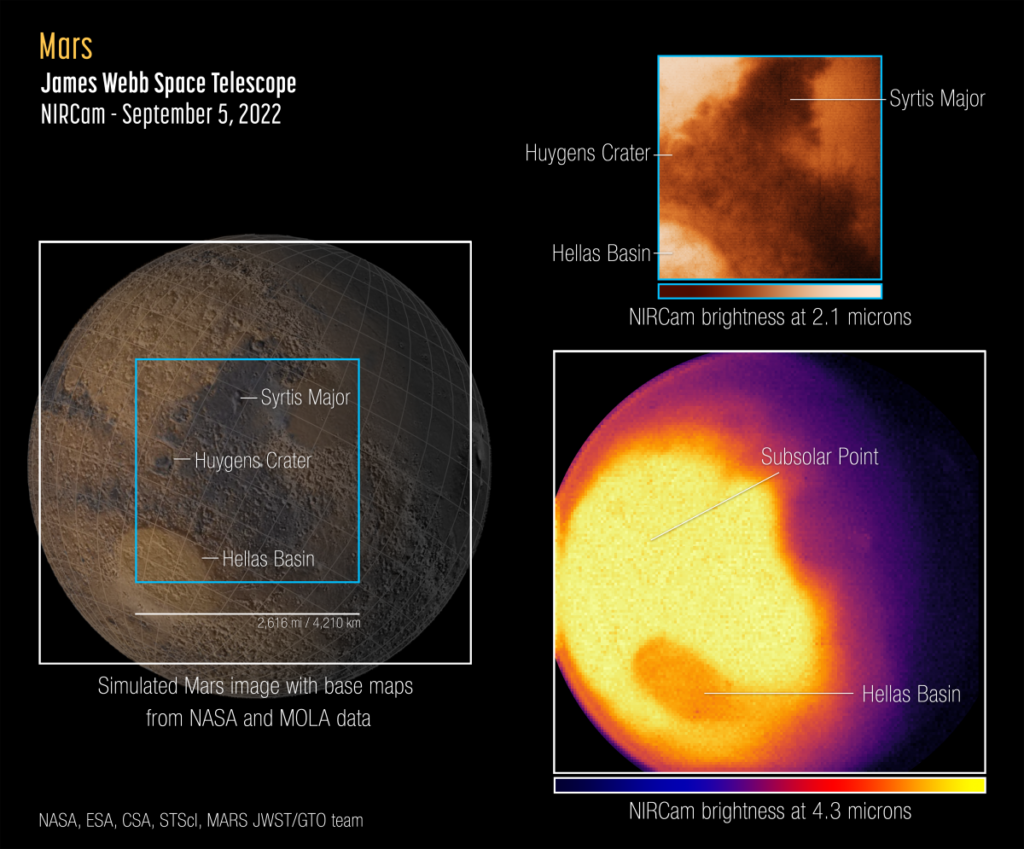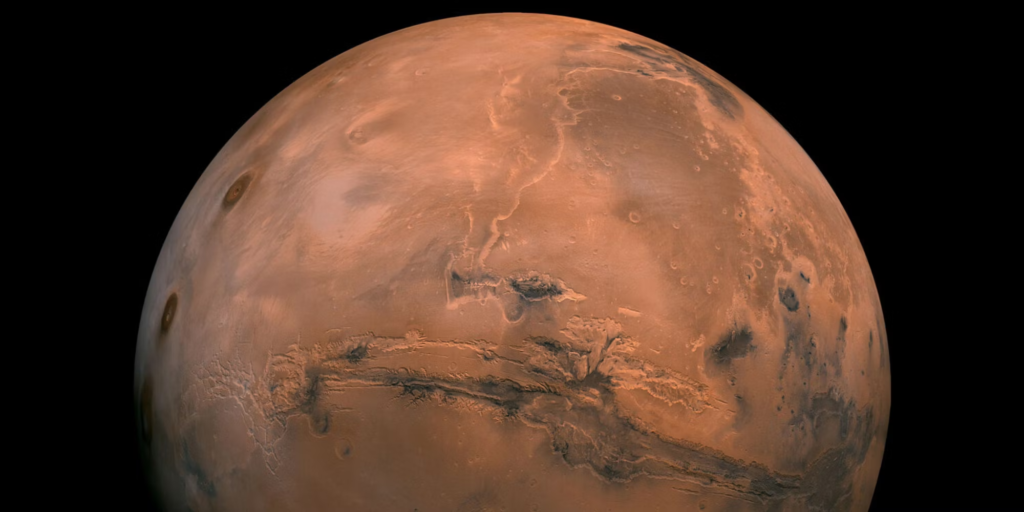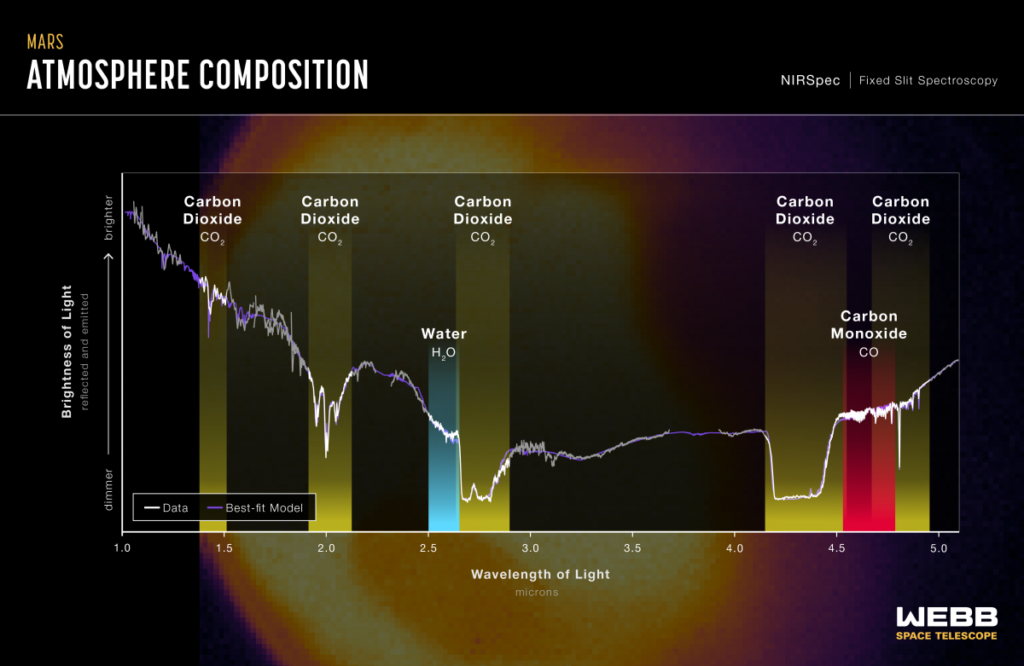
What Webb’s New Images of Mars Reveals About The Planet
The James Webb Space Telescope continues to stay busy with constant science operations and general tasks. As we approach a year since the next generation space telescope was launched, Webb is still going strong and performing better than expected. Each update helps solidify the fact that the JWST manages to consistently produce extremely unique and fascinating images and data.
Just yesterday NASA released new information and images on our planetary neighbor, Mars. Specifically, taken on September 5th, Webb captured its first images and spectra of the Martian planet. The agency highlighted this new data provides a unique perspective with its infrared sensitivity on our neighboring planet, complementing data being collected by orbiters, rovers, and other telescopes.
One of the reasons these images are so special is not only Webb’s infrared camera properties but also the location of the telescope in relation to Mars. All of these features combined provided various results that give a completely unique perspective on the planet and its future. Here I will go more in-depth into the recent Webb images, why they are so important, what to expect in the coming months, and more.
New Mars Image

Just earlier this month NASA released some of Webb’s first fascinating exoplanet images. Now just a few weeks later we are receiving a unique perspective on Mars. These new images provide a view of Mars’ observable disk (the portion of the sunlit side that is facing the telescope). As a result, Webb can capture images and spectra with the spectral resolution needed to study short-term phenomena like dust storms, weather patterns, seasonal changes, and, in a single observation, processes that occur at different times (daytime, sunset, and nighttime) of a Martian day, which is almost exactly the same as a day here on Earth. In addition, because it is so close, the Red Planet is one of the brightest objects in the night sky in terms of both visible light (which human eyes can see) and the infrared light that Webb is designed to detect. This poses special challenges to the observatory, which was built to detect the extremely faint light of the most distant galaxies in the universe. Webb’s instruments are so sensitive that without special observing techniques, the bright infrared light from Mars is blinding, causing a phenomenon known as “detector saturation.” In this case, Astronomers adjusted for Mars’ extreme brightness by using very short exposures, measuring only some of the light that hit the detectors, and applying special data analysis techniques.
These first images were captured by NIRCam, also known as The Near Infrared Camera (NIRCam), which is Webb’s primary imager that covers the infrared wavelength range of 0.6 to 5 microns. These first images show a region of the planet’s eastern hemisphere at two different wavelengths, or colors of infrared light. This image shows a surface reference map from NASA and the Mars Orbiter Laser Altimeter (MOLA) on the left, with the two Webb NIRCam instrument field of views overlaid. The near-infrared images from Webb are on shown on the right.
Taking a more detailed look, at the top right, the NIRCam image shows 2.1-micron (F212 filter) reflected sunlight, revealing surface features such as craters and dust layers. On the bottom right, a simultaneous NIRCam image showing ~4.3-micron (F430M filter) emitted light that reveals temperature differences with latitude and time of day, as well as darkening of the Hellas Basin caused by atmospheric effects. The bright yellow area is just at the saturation limit of the detector. In other words, the top right image is dominated by reflected sunlight, and thus reveals surface details similar to those apparent in visible-light images, such as the ones on the left. However, the lower right image shows thermal emission – light given off by the planet as it loses heat. The brightness of 4.3-micron light is related to the temperature of the surface and the atmosphere. The brightest region on the planet is where the Sun is nearly overhead, because it is generally warmest. The brightness decreases toward the polar regions, which receive less sunlight, and less light is emitted from the cooler northern hemisphere, which is experiencing winter at this time of year.
This being said, NASA points out that temperature is not the only factor affecting the amount of 4.3-micron light reaching Webb with this filter. As light emitted by the planet passes through Mars’ atmosphere, some gets absorbed by carbon dioxide (CO2) molecules. The Hellas Basin – which is the largest well-preserved impact structure on Mars, spanning more than 1,200 miles (2,000 kilometers) – appears darker than the surroundings because of this effect. A principal investigator who designed these observations explained that, “This is actually not a thermal effect at Hellas. The Hellas Basin is a lower altitude, and thus experiences higher air pressure. That higher pressure leads to a suppression of the thermal emission at this particular wavelength range [4.1-4.4 microns] due to an effect called pressure broadening. It will be very interesting to tease apart these competing effects in these data.”
NIRSpec Findings

In addition to the collage of images shown prior, Webb also used some of its other instruments to gather even more information about the red planet. Specifically, NASA also released Webb’s first near-infrared spectrum of Mars, demonstrating Webb’s power to study the Red Planet with spectroscopy. Spectroscopy is simply a scientific method of studying objects and materials based on color. More specifically, spectroscopy involves analyzing spectra: the detailed patterns of colors (wavelengths) that materials emit, absorb, transmit, or reflect.
In terms of the recent Marks observations, whereas the images highlighted prior show differences in brightness integrated over a large number of wavelengths from place to place across the planet at a particular day and time, the spectrum shows the subtle variations in brightness between hundreds of different wavelengths representative of the planet as a whole. Astronomers will analyze the features of the spectrum to gather additional information about the surface and atmosphere of the planet. Looking at the results, the spectrum is dominated by reflected sunlight at wavelengths shorter than 3 microns and thermal emission at longer wavelengths. NASA pointed out that preliminary analysis reveals the spectral dips appear at specific wavelengths where light is absorbed by molecules in Mars’ atmosphere, specifically carbon dioxide, carbon monoxide, and water. Other details reveal information about dust, clouds, and surface features. By constructing a best-fit model of the spectrum, by the using, for example, the Planetary Spectrum Generator, abundances of given molecules in the atmosphere can be derived.
This infrared spectrum was obtained by combining measurements from all six of the high-resolution spectroscopy modes of Webb’s Near-Infrared Spectrograph (NIRSpec). The initial analysis of the spectrum shows a rich set of spectral features that contain information about dust, icy clouds, what kind of rocks are on the planet’s surface, and the composition of the atmosphere. The spectral signatures – including deep valleys known as absorption features – of water, carbon dioxide, and carbon monoxide are easily detected with Webb. The researchers have been analyzing the spectral data from these observations and are preparing a paper they will submit to a scientific journal for peer review and publication. It’s important to point out that scientific peer review is a long-established, quality-control system, where new scientific discoveries are scrutinized by experts before they are published in a journal. The peer review process begins when a scientist or group of scientists completes a study of a particular object in the sky and then submits their written findings to an accredited journal for publication.
The journal’s editors will then circulate the article to other scientists within the same field to gather their reviews and feedback. Only articles that meet good scientific standards, acknowledging and building upon other known works, make it through this process and are published in the journal. NASA relies on this peer-review process to ensure the quality and accuracy of scientific results before sharing them with the public. NASA points out that since Webb’s discoveries are so new, they require time to be vetted by the peer-review process, and a pipeline of articles under peer review is growing as the telescope continues to make observations from its first year of planned science. These recent images and data on Mars from Webb join the long list of fascinating discoveries going through this exact process. As time goes on the agency is expected to continue releasing more images and data from the next generation space telescope.
Conclusion
The James Webb Space Telescope took images and gathered data on the Martian planet earlier this month. Just yesterday NASA released some of the initial findings and images that were taken. These give us a better idea of different surface conditions, planet features, molecules, and much more. We will have to wait and see how it progresses and the impact it has on the space industry.
